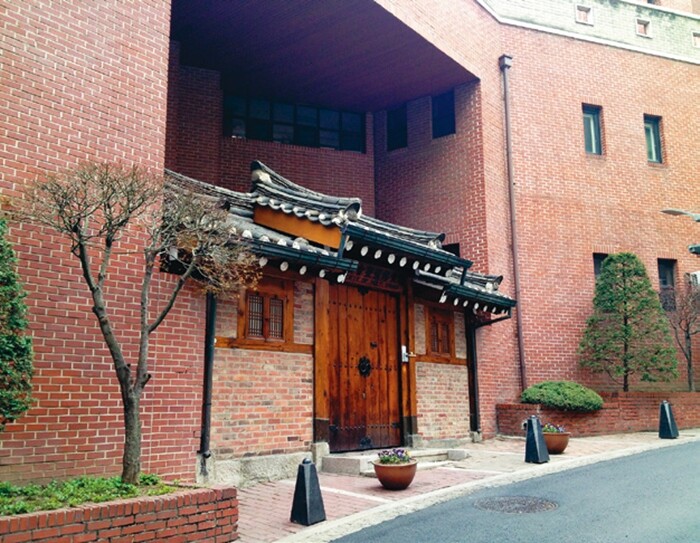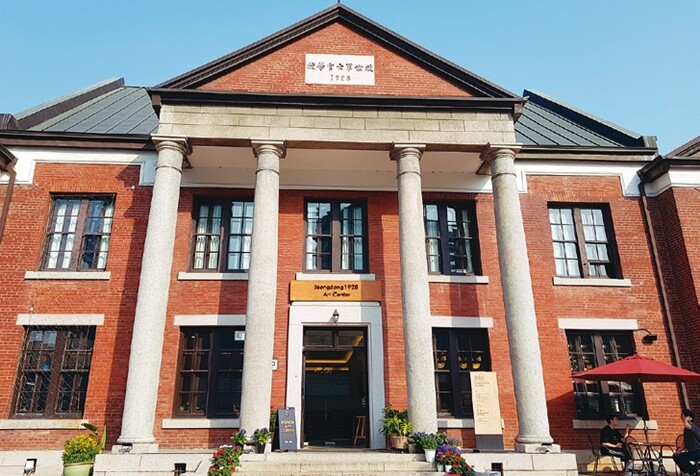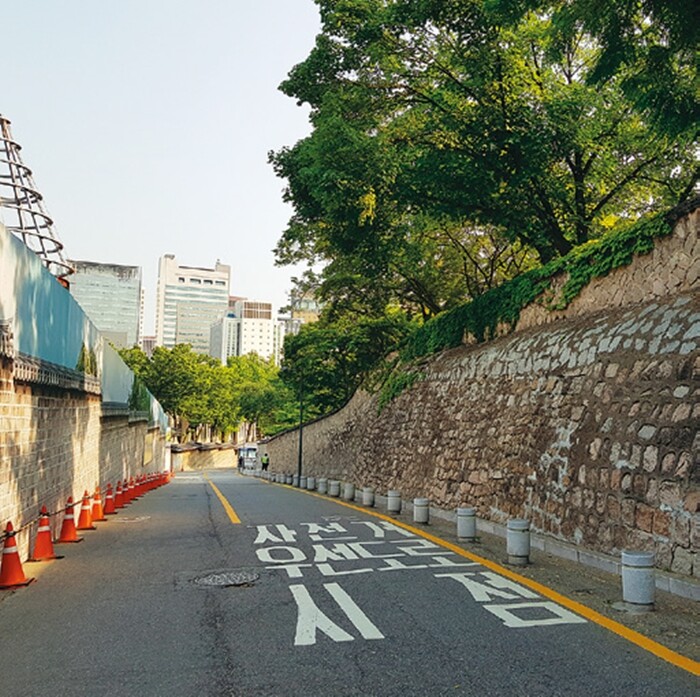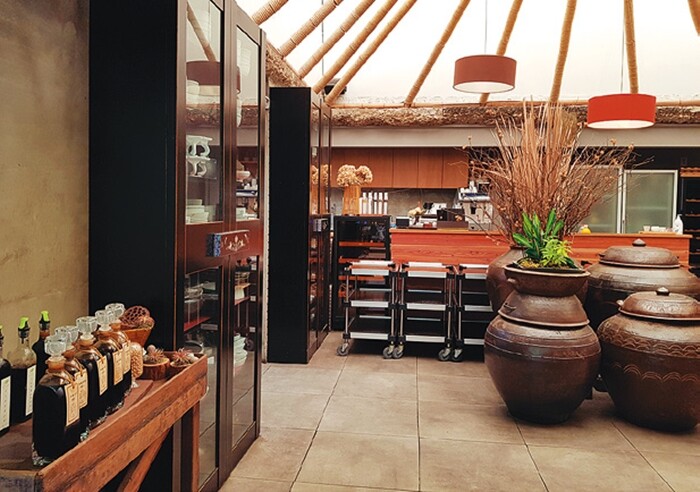hankyoreh
Links to other country sites 다른 나라 사이트 링크
[Seoul travels] A journey through modern Korean history in Jeongdong

Some people have a condition called hypergraphia, a severe addiction to writing. That’s definitely not something I have to worry about.
In fact, my issue is what people in the English-speaking world know as writer’s block. I want to write, but I just can’t seem to put anything on the page.
While flipping through a past issue of the New Yorker magazine, my eyes pause on an intriguing title: “Why Walking Helps Us Think.”
The article explains that taking a walk gets the heart pumping, sending more blood and oxygen circulating not only through the muscles but through all the organs in the body. And one of those organs, needless to say, is the brain.
When we walk, the brain systematizes the world around us; when we write, the brain systematizes our thoughts. That suggests that there is a deep connection between walking, thinking, and writing. In short, if I want to start writing again, I need to go for a walk.

Slipping on my sneakers, I head out of my house and take the Seoul subway to City Hall Station. Coming out of Exit 4, I walk toward Gwanghwamun Square until I reach the Press Center on my right. I head into the building and hop onto the elevator, getting off at the 20th floor.
This floor holds the press club and a banquet hall, but my goal today is the men’s bathroom. I’m hoping to take a photo through a window in that bathroom.
The window looks out on the greenery of Deoksu Palace, the striking red roof of the Seoul Anglican Cathedral, the Seoul Metropolitan Council building, and Seoul City Hall. The location being what it is, I carefully stick my phone out of the window and hurriedly snap a few shots before heading back down the elevator.
Crossing the street, I head toward Sejong-daero 19-gil, an alley running along Deoksu Palace’s stone wall. This is the site of the Seoul Hall of Urbanism and Architecture, the Cecil Theater, and the British Embassy.
The democracy protests of the 70s and 80s surrounding Cecil TheaterThe Cecil Theater was the cradle of the small theater movement in the 1970s and 1980s. Cecil Restaurant was the tinderbox of the democracy protests in June 1987 and frequently hosted press conferences. As a journalist, I had a chance to witness those stunning historical events.
According to a pamphlet titled “Stories of Jeongdong,” published by a local historical association, the name “Cecil” was inspired by Alfred Cecil Cooper, the fourth bishop of the Anglican Church in Korea.
After being expelled by the Japanese colonial authorities, Cooper returned to Korea following its liberation only to be abducted by North Korean troops after the outbreak of the Korean War. When prisoners of war were being repatriated, Cooper was released in Moscow, but soon returned to Seoul by way of London.
Thus, the restaurant’s name expresses those turbulent times. Cecil Restaurant was closed in 2008; today, the spot is occupied by a restaurant called Dalgaebi that offers conference rooms.

Located at the end of the alley is the British Embassy, whose foundations were laid back in 1890. It’s certainly one of the most venerable Western structures in the area. In 1992, the building got a facelift, to repair a century’s wear and tear. Prince Charles and Princess Diana even attended the opening ceremony.
After coming back to the alley’s entrance, I walk through an above-ground parking lot to reach the Anglican Cathedral, a building with stunning Romanesque architecture.
The building site was acquired in 1909 and the building consecrated in 1926. But construction under the original blueprints wasn’t completed until 1996. Since then, the building has become a veritable landmark in the neighborhood, even for those who aren’t religious.
Café Grace, in the middle of the cathedral grounds, is a popular place for office workers in the area to relax, both because of its generous view of Seoul Square and because of the affordable coffee sold there.
The building that contains a model of the Cheomseongdae observatory is the Seoul Hall of Urbanism and Architecture.

Heading right into the alley next to the Seoul Metropolitan Council building, I come upon an Anglican convent associated with the Society of the Holy Cross. The building itself is Western in design, but the entrance has a gorgeous tile roof drawn from traditional Korean architecture.
This alley, which passes by the Chosun Ilbo newspaper building, hosts a number of restaurants and cafés, such as Mongro and Gwanghwamun Gukbap, that have pioneered culinary trends over the past few years.
Emerging from the alley, I find myself right in front of Dongwha Duty Free Shop. The street here was once lined with buses carrying Chinese tourists, but now it feels like a ghost town.
A short jaunt down two alleys — Saemunan-ro 2-gil and Deoksugung 2-gil — brings me to Deoksu Elementary School, on the left, and a construction site, formerly Gyeonggi Girls’ High School, on the right. At one time, the two schools were regarded as some of Korea’s finest.
A little further on, I come upon a building of red brick and stone pillars. The four neoclassical pillars at the entrance to the building, which was completed in 1928, were reportedly modeled on the façade of a London orphanage known as Congress Hall.

The building once housed Korea’s oldest surviving seminary and also served as the headquarters of the Salvation Army, the organization famed for soliciting donations with red kettles at Christmas. Today, the left wing of the building has become the Salvation Army museum, while the central building is now the Jeongdong 1928 Art Center.
This is a multipurpose cultural center complete with a performance hall, galleries for exhibitions, a liberal arts academy, and a photo studio. But its actual offerings have been severely curtailed by the ongoing pandemic.
Entering the auditorium on the second floor, which is open to the public, I’m impressed to see the roof held up by hammer beam trusses, without any pillars to support it.
It’s rare to see a religious building with gable walls and a gable roof. I’m told that this design choice sought to present modesty and simplicity, rather than flashiness.
For those taking a stroll through this alley, the café in this building is perfect for a cup of tea and some reading.
Following the stone wall at Deoksu Palace back into the alley, I come to Habib House, the residence of the American ambassador to Seoul, with its complement of security guards. A little further along the wall is a tiny alley concealing the restaurant Congdu.
This unassuming restaurant, which serves Korean dishes largely composed of soybeans and derived seasonings, is a go-to meeting place for office workers in Gwanghwamun.
Taking a left from here, I pass by the rear entrance to the British ambassador’s residence. Further on in the alley is the side entrance to Deoksu Palace. Passing through this door brings me back to Cecil Theater, or at least it would if not for COVID-19.
I can feel the sun beating down as I walk toward City Hall Station. I guess I better listen to the song “Ain’t No Sunshine” from the film “Notting Hill” and eat a refreshing bowl of patbingsu, a dessert made of shaved ice.
By Son Kwan-seung, travel writer
Please direct comments or questions to [english@hani.co.kr]
Editorial・opinion
![[Column] Season 2 of special prosecutor probe may be coming to Korea soon [Column] Season 2 of special prosecutor probe may be coming to Korea soon](https://flexible.img.hani.co.kr/flexible/normal/500/300/imgdb/original/2024/0426/3317141030699447.jpg) [Column] Season 2 of special prosecutor probe may be coming to Korea soon
[Column] Season 2 of special prosecutor probe may be coming to Korea soon![[Column] Park Geun-hye déjà vu in Yoon Suk-yeol [Column] Park Geun-hye déjà vu in Yoon Suk-yeol](https://flexible.img.hani.co.kr/flexible/normal/500/300/imgdb/original/2024/0424/651713945113788.jpg) [Column] Park Geun-hye déjà vu in Yoon Suk-yeol
[Column] Park Geun-hye déjà vu in Yoon Suk-yeol- [Editorial] New weight of N. Korea’s nuclear threats makes dialogue all the more urgent
- [Guest essay] The real reason Korea’s new right wants to dub Rhee a founding father
- [Column] ‘Choson’: Is it time we start referring to N. Korea in its own terms?
- [Editorial] Japan’s rewriting of history with Korea has gone too far
- [Column] The president’s questionable capacity for dialogue
- [Column] Are chaebol firms just pizza pies for families to divvy up as they please?
- [Column] Has Korea, too, crossed the Rubicon on China?
- [Correspondent’s column] In Japan’s alliance with US, echoes of its past alliances with UK
Most viewed articles
- 1AI is catching up with humans at a ‘shocking’ rate
- 2[Column] Season 2 of special prosecutor probe may be coming to Korea soon
- 3Is Japan about to snatch control of Line messenger from Korea’s Naver?
- 4‘We must say no’: Seoul defense chief on Korean, USFK involvement in hypothetical Taiwan crisis
- 5Up-and-coming Indonesian group StarBe spills what it learned during K-pop training in Seoul
- 6The dream K-drama boyfriend stealing hearts and screens in Japan
- 7[Column] ‘Choson’: Is it time we start referring to N. Korea in its own terms?
- 8Amnesty notes ‘erosion’ of freedom of expression in Korea in annual human rights report
- 9Is N. Korea threatening to test nukes in response to possible new US-led sanctions body?
- 10Division commander ordered troops to enter raging flood waters before Marine died, survivor says